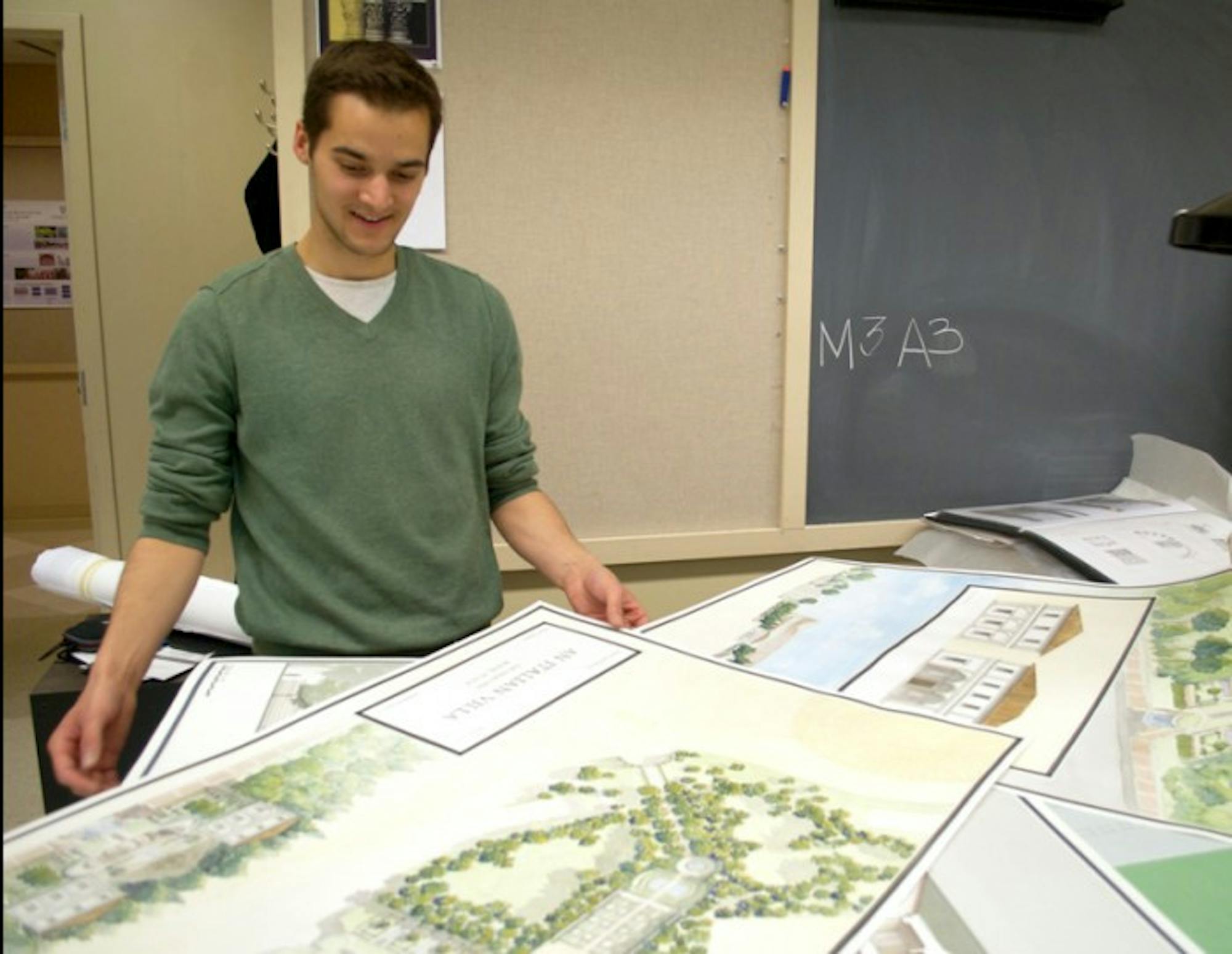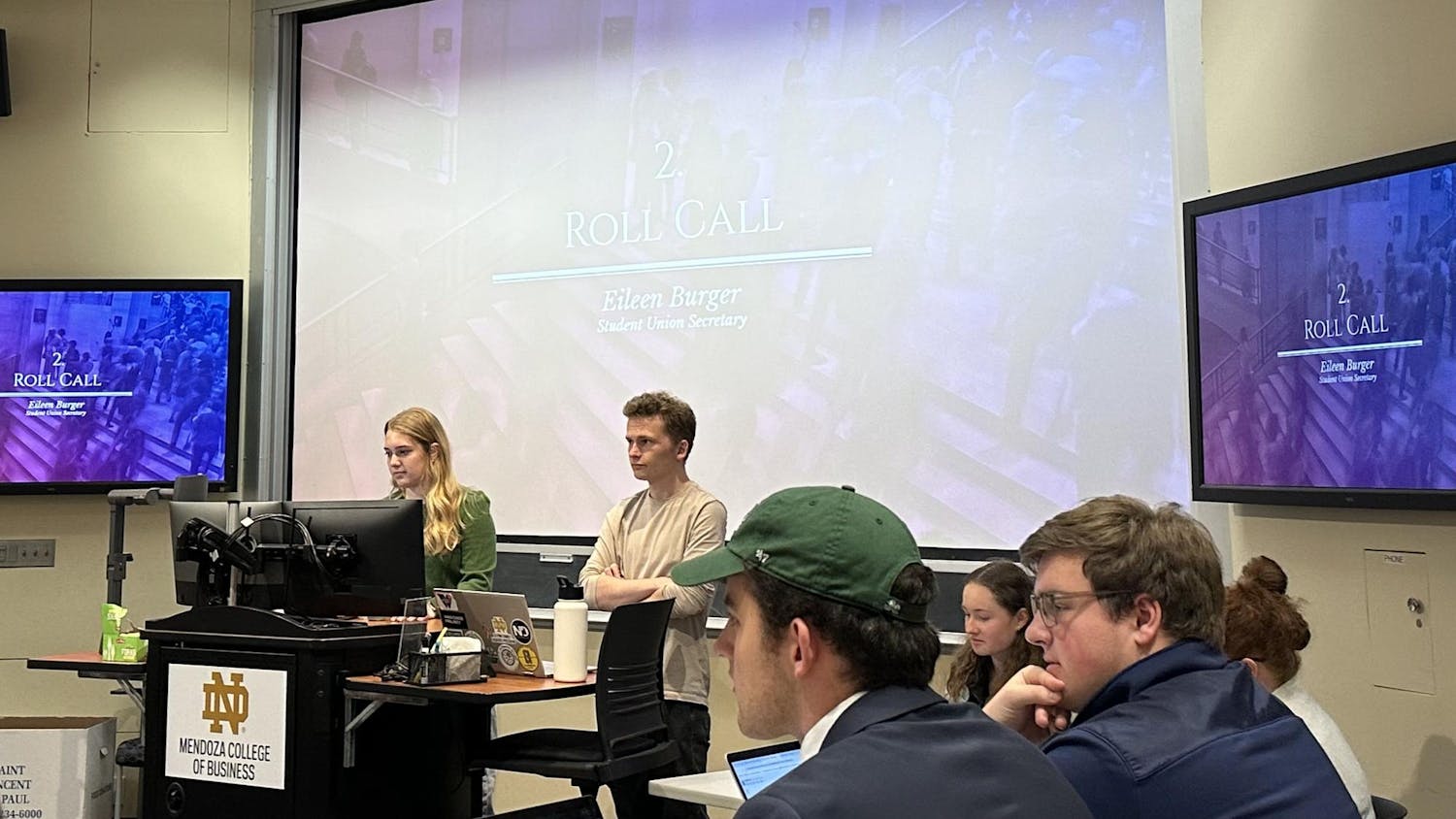Fifth-year architecture student Mark Santrach’s first surprise came when he received an invitation to apply to give the valedictory address at Notre Dame’s 169th Commencement.
“I actually didn’t know that I was even eligible,” Santrach said.

Months later, after he had just finished presenting his thesis project, a design proposal for Notre Dame’s future Matt and Joyce Walsh Family Hall of Architecture, Santrach received a phone call encouraging him to check his email.
“I was in shock,” he said. “I had to keep it confidential, and I still had to go to one more class.”
Santrach, a member of the Tau Sigma Delta Architecture Honor Society, earned a 3.993 cumulative grade point average and “achieved Dean’s List honors each semester while at Notre Dame,” according to a May 1 University press release. He said he could be Notre Dame’s first valedictorian to hail from the School of Architecture.
“I was told that it’s a once-in-a-century kind of thing,” he said. “Actually I asked … [associate professor of film and television] Dr. [Susan] Ohmer … I said, ‘Has this ever happened before?’ and she said, ‘To our knowledge, there has never been an architecture valedictorian.’”
Santrach said as a high school student, he planned to study medicine until he shadowed an emergency-room doctor and fainted during an operation.
“My mom actually ended up suggesting that I pursue architecture and … she was absolutely right,” he said. “… I used to play Sims. My brother and I used to have these competitions of who could build the most elaborate house, and I think that kind of became addicting, so I started to pursue it.”
Now, Santrach has completed theoretical design projects based on real problems that face areas as diverse as a Cuban harbor and a Tibetan refugee camp.
“[Architecture students] do hope that our ideas and proposals can actually promote … some tangible change,” he said. “So for example, I know that what I designed for my thesis isn’t going to be built, but I hope it provides a different perspective for whoever may actually get the commission.”
Santrach said his experiences encouraged him to develop a passion for using architecture and urban design in ways that will benefit groups of people or entire cities.
“I do hope to design buildings but also be involved with urbanism, whether that’s at a micro level or macro level,” he said. “… Urbanism could mean anything from changing zoning codes, or it could mean developing undeveloped lands, or it could be redeveloping existing urban forms.”
This summer, Santrach will move to London to work for Porphyrios Associates, which is “one of the most prominent classical architecture firms in the world,” according to associate professor of architecture Lucien Steil. Santrach said he previously studied the theoretical writings of the firm’s leader, Demetri Porphyrios, who in 2004 received Notre Dame’s Richard H. Driehaus Prize for Classical Architecture, according to the School of Architecture’s website.
Steil said he first came to know Santrach during their first and second years at Notre Dame, respectively. Steil said he had moved to Notre Dame from Europe and he “connected quickly with the whole class” of second-year architecture students through Santrach.
“I was immediately impressed by his charisma, his intellectual curiosity and his smile,” Steil said. “I have never seen him gloomy, impatient or irritated.”
Steil praised Santrach’s attitude as a “very kind and altruistic student” of classical architecture.
“Mark is not waiting to be taught passively but engages proactively and positively with the University and with professors, believing that learning is not a one-way consuming and digesting but a creative dialogue, a dialectical process and a joint venture benefitting most to those who invest genuinely [and who] most generously participate and most seriously commit not only to their own career but to the pedagogical ideals of their discipline,” he said.
Fifth-year architecture student Matt Cook said Santrach’s intelligence and humility promoted a better collaborative atmosphere in the class of 2014’s studio space.
“Being in class with Mark is, as you would imagine, both a little daunting and very inspiring,” he said. “… He is humble to the core, and while he does only the finest design work, he is always reticent to accept any praise for his projects because he is sure he can do better.
“The effect that Mark’s drive has on his peers is immediately perceptible in a studio environment; the quality of every student’s work is elevated as Mark’s positive attitude and desire to exceed expectations rub off on the group. Though he is an outstanding designer, Mark is always courteous of others’ ideas and celebrates good design no matter where it comes from.”
Santrach’s brother Stephen, a 2011 Notre Dame alumnus, said Mark Santrach’s work ethic and care for others sprung from their family upbringing in St. Paul, Minn.
“When we were kids, our parents made us do a lot of manual labor — mulching, tree trimming, weeding, cleaning, et cetera,” Stephen Santrach said. “At the same time, they demanded academic excellence and this fostered both mental and physical stamina that persists to this day … I think architecture for him is truly a calling.”
Mark Santrach’s sister Camille Santrach, a junior at the College of the Holy Cross in Worcester, Mass., said Mark Santrach “has always been an exceptionally hard worker” who sees projects through to their end.
“He always goes above and beyond in completing any task he is given,” she said. “He has the ability to deeply immerse himself in whatever project he is undertaking.”
Stephen Santrach said his family was “thrilled and shocked at the same time” when they found out Mark Santrach would give the valedictory address, but he said he was more pleased that his brother had found a true vocation.
“I’m most proud of my brother for pursuing his passion and being independently-minded,” Stephen Santrach said. “The valedictory is a great honor, but I am most proud of his artistic ability, work ethic and emotional stability. Mark is very comfortable in his own skin and has a very generous heart.”
Camille Santrach said Mark Santrach lives with a passion not only for architecture but also for life as a whole. She said his “distinct” and “absolutely contagious laugh” demonstrates that “while he is very serious about his work, he definitely knows how to have fun.”
“Mark does not simply go through the motions in life; he embraces it,” she said. “He is thoughtful, articulate, and passionate, and he has taught me a great deal about the art of living.”
Senior business major Sean Egan said he felt like “a proud father” when he found that Santrach had been named valedictorian. He said Santrach, who took courses in the Mendoza College of Business to complete a concentration in architectural practice and enterprise, welcomed him into his group of “arkies,” or architecture students.
“Mark is the most unassuming person you’ll ever meet,” Egan said. “He can talk with anybody about anything, and he’s present for the entirety of the conversation.”
Cook said Santrach is a “normal, down-to-earth and fun guy” whose capacity for “endless gratitude” endears him to friends, classmates and professors alike.
“He never forgets an expression of gratitude where one is needed,” Cook said. “Mark may hold the record for most handwritten thank you notes — often decorated with pressed leaves, drawings, or watercolors.
“His very vocal appreciation of the actions of others is a reminder for me, and I think everyone else in his life, that we do not live in isolation and that we have so much to be thankful for. Mark is a rare combination of talent, gratitude and humility, and I think it is this mix of outstanding traits that makes him so well loved by all.”













